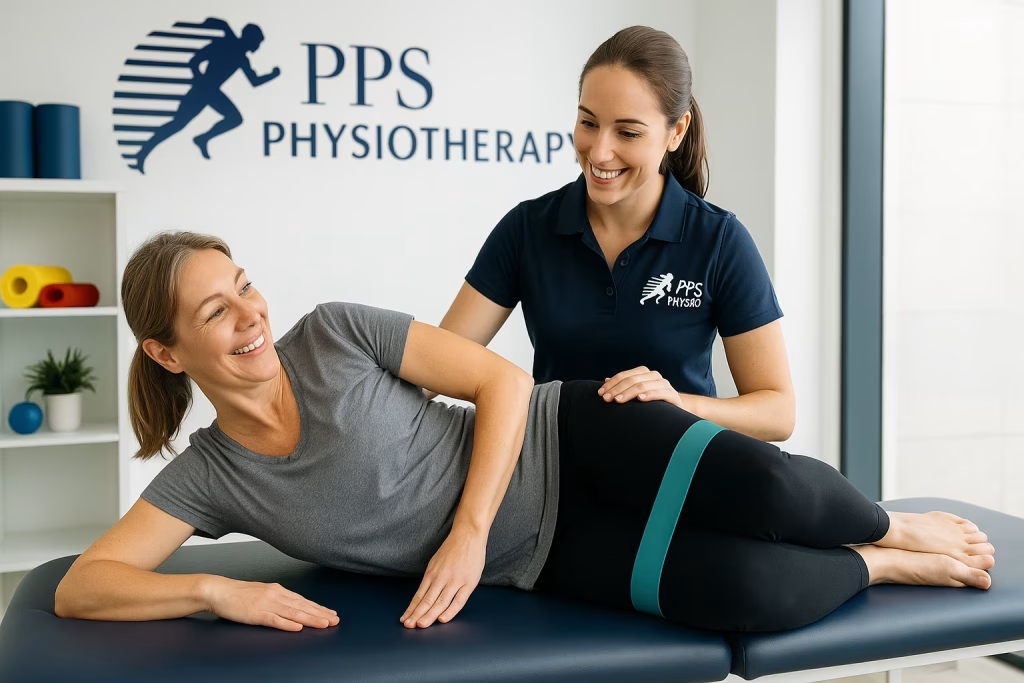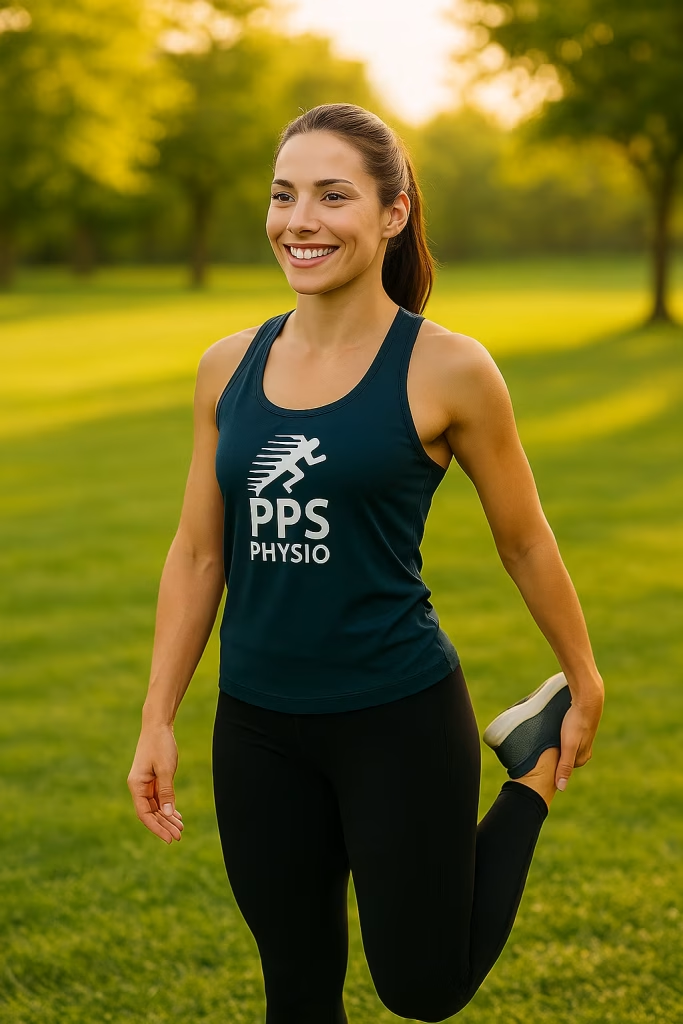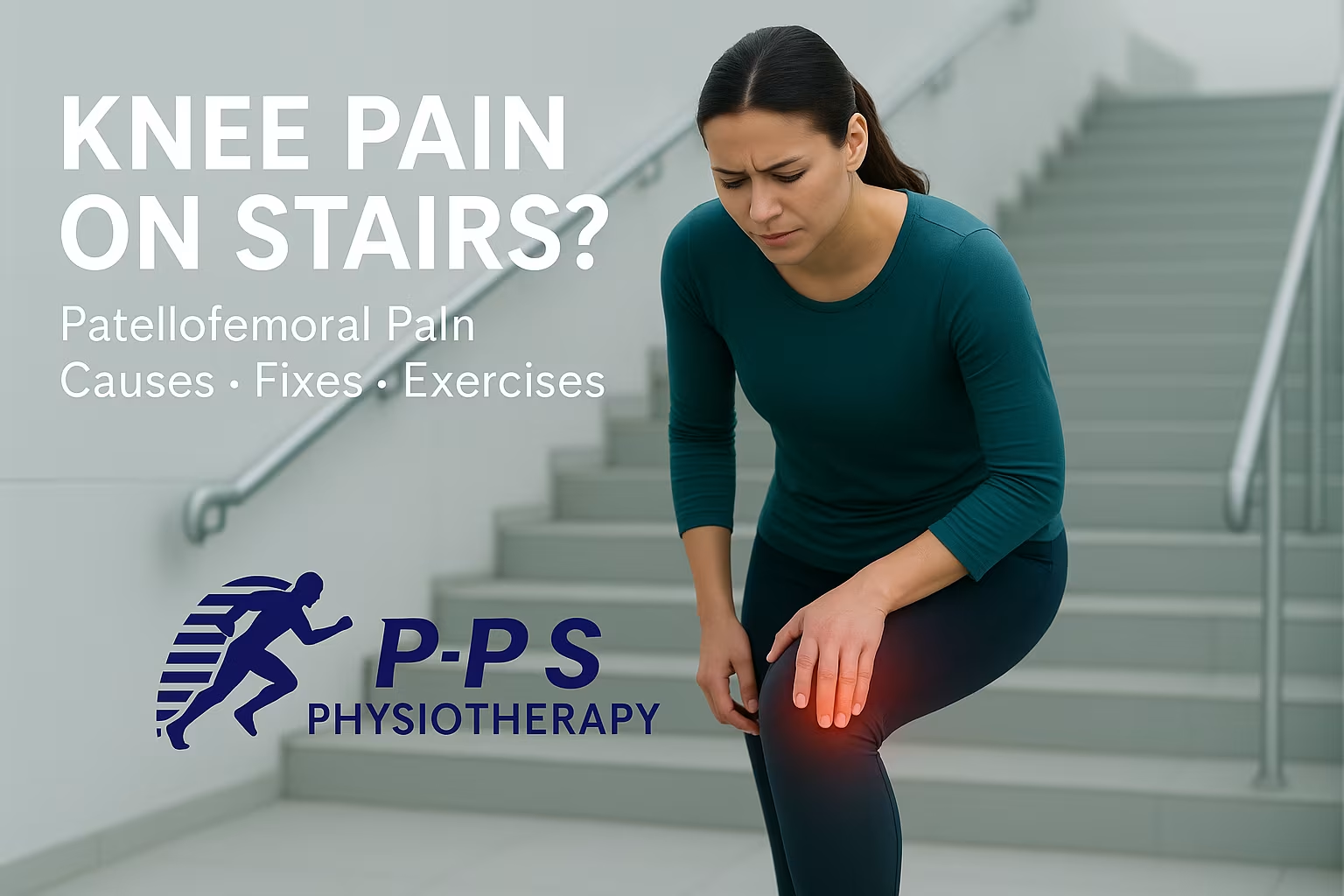Knee Pain on Stairs? Patellofemoral Pain Causes, Fixes, and Exercises
Last updated: 14 October 2025 (Sydney)
Experiencing knee pain on stairs? It’s one of the most common knee issues we see at PPS Physiotherapy in Kellyville and Carlingford. In many cases, the cause is patellofemoral pain syndrome (PFP) — when the kneecap doesn’t glide smoothly in its groove, leading to irritation during movements like stairs, squats, or prolonged sitting.
Quick answer: Patellofemoral pain occurs when the kneecap is overloaded in a bent-knee position. The best fix is a progressive, physio-guided strengthening plan for your hips and quadriceps (often VMO-focused), supported by short-term taping or activity adjustments as needed.
This condition—sometimes called “runner’s knee”—can affect anyone, from active teenagers to adults with desk jobs. In this guide, you’ll learn the causes, symptoms, and evidence-based exercises that can help you move pain-free again.
What is Patellofemoral Pain?
Patellofemoral pain occurs when the kneecap (patella) doesn’t move smoothly in the groove of the thigh bone (femur). Instead of gliding evenly, it rubs or tracks incorrectly, creating pain around or behind the kneecap. This pain is mechanical and load-related — meaning it increases with certain activities like stairs, squats, sit to stand movements or running.
It is not the same as arthritis, ligament tears, or meniscus injuries. While those can also cause knee pain, patellofemoral pain is unique because it’s closely tied to how your muscles, joints, and movement patterns work together.
- Typical age group: Teens, young adults, and runners, though it can affect anyone.
- Main symptom: Dull ache or sharp pain at the front of the knee, worse on stairs or after sitting for long periods.
- Nicknames: “Movie sign” (pain when sitting at the cinema), “runner’s knee.”
Why Does My Knee Hurt on Stairs?
Stairs dramatically increase the load on your knee joint. Research shows the pressure on the patellofemoral joint can reach 3–4 times your body weight when going upstairs, and even more when going down. If your kneecap doesn’t track properly, this stress quickly irritates the joint.
Think of it like a car tyre slightly out of alignment: each turn puts uneven wear on the wheel. Over time, that imbalance leads to pain.
Main Causes of Patellofemoral Pain
There isn’t usually one single cause — most cases come from a combination of factors:
- Muscle weakness: Weak glutes, hip muscles, or quadriceps can’t stabilise the knee properly.
- Muscle tightness: Tight quads, calves, hamstrings, or iliotibial band (ITB) increase joint pressure.
- Foot mechanics: Flat feet or overpronation can pull the knee inward, altering patella tracking.
- Training errors: Sudden increases in running, squatting, or stair use without progressive build-up.
- Postural habits: Sitting with knees bent for long periods creates continuous pressure.
Good news: Patellofemoral pain is rarely due to permanent damage. With the right rehab, most people recover fully.
Symptoms of Patellofemoral Pain
- Aching or sharp pain at the front of the knee.
- Pain climbing or descending stairs.
- Discomfort when squatting, kneeling, or lunging.
- “Movie sign” – pain after sitting with bent knees.
- Occasional cracking or grinding sounds (crepitus).
Symptoms often build gradually rather than appearing after a single injury. This makes early physiotherapy assessment important, as ignoring symptoms may lead to chronic pain.
How Physiotherapy Helps Patellofemoral Pain
Physiotherapy is the first-line treatment for PFP. At PPS Physiotherapy, our approach includes:
- Comprehensive assessment: Identifying which muscles and movement patterns are contributing to your pain.
- Hands-on treatment: Manual therapy, massage, or taping to relieve symptoms quickly.
- Targeted exercise program: Strengthening glutes, quads, and core for long-term stability.
- Load management: Adjusting activity levels to allow healing while keeping you active.
- Education: Helping you understand the condition and avoid aggravating habits.
Most patients notice improvement within 3–6 weeks of consistent physiotherapy-guided rehab.
Evidence-Based Exercises for Patellofemoral Pain
1. Clamshells (Glute Activation)
Improves hip strength and knee control.
- Lie on your side with knees bent.
- Lift the top knee while keeping feet together.
- Perform 2–3 sets of 12 reps per side.

2. Step Downs
Trains stability for stair use.
- Stand on a step with one foot off the edge.
- Slowly bend your supporting leg and lower the opposite heel toward the ground.
- Perform 3 sets of 10 reps.
3. Wall Sit with Ball Squeeze
Targets quads and inner thigh muscles.
- Lean against a wall with knees bent at 90°.
- Place a ball or pillow between your knees.
- Squeeze and hold for 30–45 seconds. Repeat 3–5 times.
4. Side-Lying Leg Raises
Strengthens hip stabilisers.
- Lie on your side with the bottom leg bent.
- Lift the top leg straight up, keeping toes forward.
- Perform 3 sets of 12–15 reps.
5. Foam Roller ITB Release
Reduces outer thigh tension.
- Place foam roller under the side of your thigh.
- Roll slowly from hip to knee for 1–2 minutes.
Tip: These are starting exercises. Your physiotherapist may progress you to weighted squats, lunges, or plyometric training depending on your goals.
Long-Term Prevention Strategies
- Build strength gradually: Increase training loads by no more than 10% per week.
- Maintain flexibility: Regularly stretch quads, calves, and hips.
- Footwear check: Supportive shoes reduce poor knee alignment.
- Workstation setup: Avoid sitting too long with knees bent; take standing breaks.
- Warm-up properly: Dynamic warm-ups before sport reduce knee stress.

When to See a Physiotherapist
You should book an appointment if:
- Knee pain has lasted longer than 1–2 weeks.
- Pain is worsening despite rest or self-care.
- Everyday activities like stairs, squats, or sitting are affected.
- You are an athlete or active individual wanting a safe return to sport.
PPS Physiotherapy has clinics in Kellyville and Carlingford, serving the wider North-West Sydney community.
Frequently Asked Questions (FAQ)
What is the fastest way to relieve patellofemoral pain?
Short-term relief may come from ice/heat, activity modification, and patella taping techniques. Long-term recovery requires physiotherapy-guided strengthening.
Can physiotherapy cure patellofemoral pain?
Yes, most people recover fully with a structured exercise program and guidance from a physiotherapist.
Is knee cracking a sign of patellofemoral pain?
Cracking (crepitus) is common and often harmless. If it comes with pain, it may be linked to patellofemoral issues (but not always).
Who is the best physio near Kellyville for patellofemoral pain?
PPS Physiotherapy has been treating knee pain in Kellyville and Carlingford since 2012, offering evidence-based care tailored to your goals.
Book an Appointment
If knee pain is stopping you from enjoying sport, stairs, or daily life, book your appointment online with PPS Physiotherapy today. Our experienced physios in Kellyville and Carlingford will help you get moving pain-free again.
References (Evidence)
- Crossley KM, et al. Patellofemoral pain consensus statement. Br J Sports Med. 2016;50(14):844–852.
- JOSPT Clinical Practice Guideline: Patellofemoral Pain. J Orthop Sports Phys Ther. 2019;49(9):CPG1–CPG95.
- Neal, B. S., Lack, S. D., Bartholomew, C., & Morrissey, D. (2024). Best practice guide for patellofemoral pain based on synthesis of a systematic review, the patient voice and expert clinical reasoning. British Journal of Sports Medicine, 58(24), 1486–1495.
- Powers, C. M., Ho, K.-Y., Chen, Y.-J., Souza, R. B., & Farrokhi, S. (2014). Patellofemoral joint stress during weight-bearing and non-weight-bearing quadriceps exercises. Journal of Orthopaedic & Sports Physical Therapy, 44(5), 320–327.

